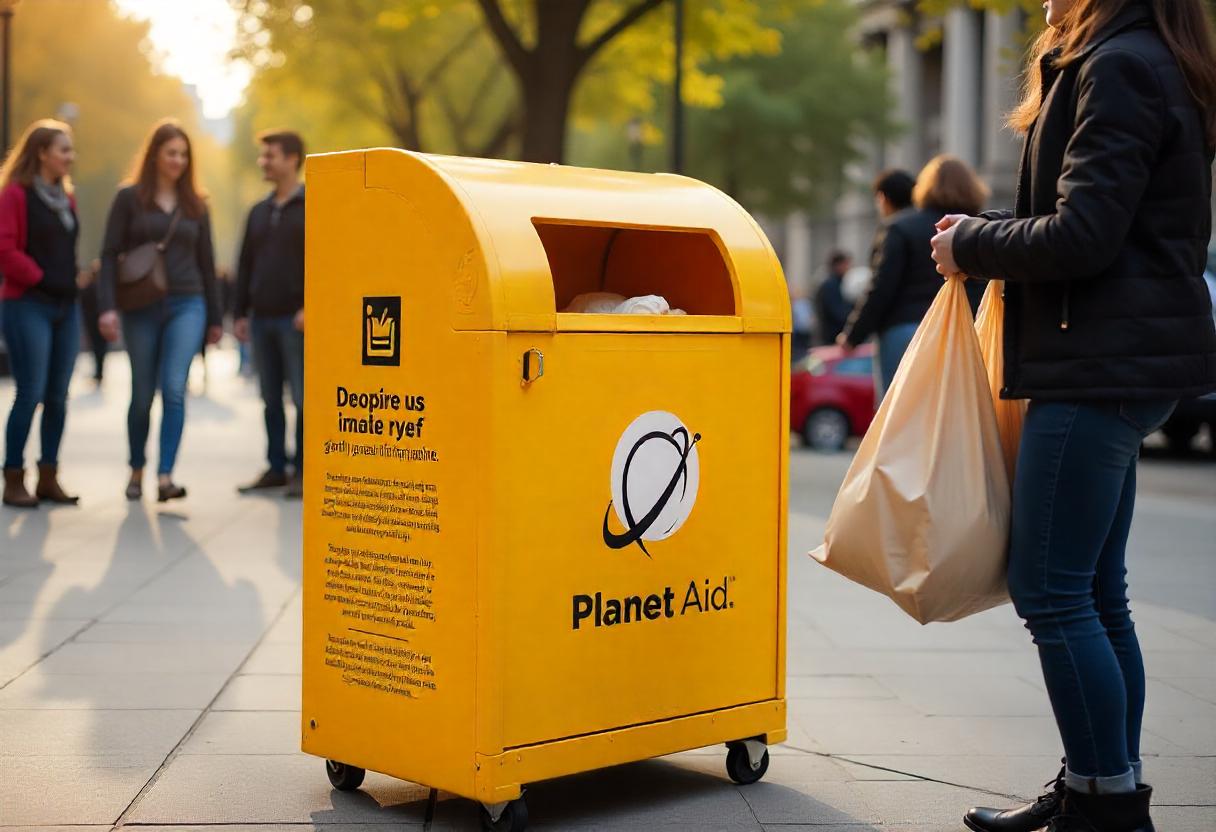Every year, millions of pounds of clothing end up in landfills, contributing to environmental pollution and waste. Instead of letting unwanted clothes and textiles go to waste, donating them to organizations like Planet Aid offers a sustainable solution. Planet Aid donation bins provide an easy and accessible way to recycle clothing while supporting charitable causes worldwide. These bright yellow bins have become a familiar sight in communities, offering a convenient way for individuals to donate items they no longer need.
Whether you’re looking to declutter your wardrobe, help those in need, or contribute to environmental sustainability, understanding how these donation bins work and their impact is essential. This article explores the benefits of using a Planet Aid donation bin, where to find one, what you can donate, and how your contributions make a difference.
Why Choose Planet Aid Donation Bins?
Convenience and Accessibility
One of the biggest advantages of Planet Aid donation bins is their accessibility. Unlike traditional donation centers that may have limited operating hours, these bins are available 24/7, allowing you to donate at your convenience. Whether you’re running errands, heading to work, or cleaning out your closet, dropping off donations takes only a few minutes.
Promoting Sustainability
Did you know that textile waste is one of the fastest-growing environmental problems? According to the Environmental Protection Agency (EPA), only 15% of discarded textiles are recycled, while the rest end up in landfills. By using a Planet Aid donation bin, you help reduce waste and conserve valuable resources. Recycling clothing requires far less energy and water compared to producing new garments, making it an environmentally responsible choice.
Supporting Global Humanitarian Efforts
Donations collected through Planet Aid go beyond just recycling—they fund educational programs, health initiatives, and sustainable development projects around the world. The organization partners with various humanitarian efforts, ensuring that your contributions help communities in need, particularly in developing countries.
How to Find a Planet Aid Donation Bin Near You
Finding a Planet Aid donation bin is simple. The organization has placed bins in high-traffic areas such as shopping centers, parking lots, schools, and community centers. To locate the nearest bin:
- Visit the official Planet Aid website and use the bin locator tool.
- Check local grocery store or retail parking lots, as many businesses support the initiative.
- Contact your city or town hall to ask if they partner with Planet Aid for textile recycling.
If your community lacks a bin, consider advocating for one by reaching out to local authorities or businesses that might host one on their property.
What Items Can You Donate?
Before dropping off donations, it’s important to know what items are accepted. Planet Aid bins primarily collect gently used clothing and textiles, including:
Clothing – Shirts, pants, dresses, skirts, jackets, coats, and sweaters.
Shoes – Sneakers, boots, sandals, and dress shoes (paired and in good condition).
Accessories – Belts, handbags, scarves, gloves, and hats.
Household Textiles – Curtains, sheets, pillowcases, and towels.
Items NOT Accepted
To maintain the integrity of the donation process, some items should not be placed in a Planet Aid bin, such as:
Wet, moldy, or severely damaged clothing
Mattresses and furniture
Electronic waste
Food, books, or non-textile items
How Your Donations Make a Difference
Reducing Environmental Impact
Every donation helps prevent textiles from being discarded in landfills. The environmental benefits of textile recycling include:
- Lower carbon emissions – Producing new fabrics generates greenhouse gases, while recycling reduces the need for new production.
- Conserving natural resources – Less water, energy, and raw materials are needed when existing textiles are repurposed.
- Minimizing landfill waste – Textile waste takes years to decompose, releasing harmful chemicals into the soil and water.
Empowering Communities
The revenue generated from recycled clothing supports educational and vocational training programs in Africa, Asia, and Latin America. These programs focus on literacy, teacher training, and skills development, helping individuals gain economic independence.
Creating Jobs
Textile recycling is a growing industry that creates jobs at various stages, from collecting and sorting donations to processing and distributing usable clothing. This contributes to economic growth while promoting sustainability.
How to Ensure Your Donations Are Effective
Prepare Your Donations Properly
- Clean and Fold – Ensure clothing is washed and free of stains, holes, or strong odors.
- Bag Items – Place donations in a sealed plastic bag to protect them from moisture and dirt.
- Avoid Overfilling – If a bin is full, find another location rather than leaving items outside, where they may become damaged.
Encourage Others to Donate
Spread the word about Planet Aid donation bins by:
- Organizing a clothing drive with friends, family, or coworkers.
- Sharing information on social media about donation bin locations.
- Encouraging local businesses and schools to host donation bins.
Common Myths About Clothing Donation Bins
Myth: Donated Clothes Are Thrown Away
✅ Fact: The majority of donated items are reused, resold, or recycled into new textiles, insulation, and industrial materials.
Myth: You Can Only Donate Designer Clothes
✅ Fact: Donations don’t have to be luxury brands! Any gently used clothing is valuable and can be repurposed.
Myth: The Donations Stay in the U.S.
✅ Fact: Many donations support international aid programs, providing clothing and funding to underprivileged communities.
Also read: Plasma Donation Milwaukee: Earn & Save Lives Today
Alternatives to Planet Aid Donation Bins
If there are no Planet Aid bins nearby, consider other donation options:
- Local thrift stores – Organizations like Goodwill and The Salvation Army accept clothing donations.
- Homeless shelters – Many shelters accept warm clothing, especially during colder months.
- Textile recycling programs – Some retailers, such as H&M and Patagonia, offer in-store clothing recycling.
Conclusion
Donating to a Planet Aid donation bin is a simple yet impactful way to promote sustainability and support global humanitarian efforts. Whether you’re decluttering, reducing waste, or contributing to charity, your donations make a real difference. By choosing to recycle your clothing responsibly, you help build a better world—one donation at a time.
FAQs
How does Planet Aid use the money from clothing donations?
Planet Aid generates revenue by selling donated clothing to secondhand markets. The funds support global development projects such as education, health services, and environmental initiatives.
Can I donate damaged or old clothing?
Slightly worn or faded clothing is fine, but heavily damaged or soiled items should not be donated. Some fabric recycling centers accept unusable textiles.
Are donations tax-deductible?
Yes, but only when donating directly to Planet Aid’s office or participating in their scheduled donation events. Bin donations typically do not provide receipts.
Do I need to sort my donations?
No, but placing items in a sealed bag keeps them clean and protected. Sorting by category (clothing, shoes, accessories) can be helpful for processing.
What happens if a donation bin is full?
If a bin is overflowing, avoid leaving items outside. Instead, use the bin locator tool to find another nearby donation spot.
How often are donation bins emptied?
Planet Aid regularly services bins, but pickup frequency depends on location and donation volume.
Can businesses or schools request a donation bin?
Yes! Planet Aid partners with organizations willing to host bins on their property. Contact them via their website to inquire about hosting.

 HUMAN RIGHTS3 months ago
HUMAN RIGHTS3 months ago
 SOCIAL AWARENESS3 months ago
SOCIAL AWARENESS3 months ago
 SOCIAL AWARENESS3 months ago
SOCIAL AWARENESS3 months ago
 HUMAN RIGHTS4 months ago
HUMAN RIGHTS4 months ago
